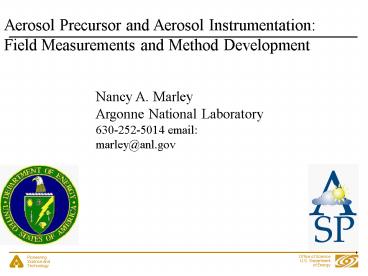Aerosol Precursor and Aerosol Instrumentation: - PowerPoint PPT Presentation
1 / 16
Title:
Aerosol Precursor and Aerosol Instrumentation:
Description:
Sunday 6/27/04. Sunday 7/04/04. 10 Times Lower than Mexico ... BC low due to decreased heavy diesel. 12. Pioneering. Science and. Technology. Office of Science ... – PowerPoint PPT presentation
Number of Views:99
Avg rating:3.0/5.0
Title: Aerosol Precursor and Aerosol Instrumentation:
1
Aerosol Precursor and Aerosol Instrumentation
Field Measurements and Method Development
Nancy A. Marley Argonne National
Laboratory 630-252-5014 email marley_at_anl.gov
2
Field Measurements Selected instrumentation
aimed at determining the amounts of scattering
and absorbing aerosols as well as their
precursors will be deployed at ground-based ASP
field sites during ASP field efforts and the data
obtained will be made available to the ASP
community. Focused Laboratory Studies To
identify and quantitate highly colored organic
carbonaceous aerosol components known as
humic-like substances and to determine their
effects on the radiative properties of
carbonaceous aerosols.
3
Aerosol Precursors Tunable Diode Laser
Spectroscopy Ammonia Near IR Open Path
Absorption System
TELESCOPE
RETROREFLECTOR
CONTROL MODULE
4
Fiber Optic
CONTROL MODULE
Focusing Lens
Removable Calibration Cell
GaAs diode laser 0.7-2.7 ?m.
Reference Cell
Detector
5
Estimated detection limits and line
characteristics for measurement of ammonia with
the NIRTDL system.
Gives a detection limit of 0.8 ppb for a path
length of 244 m or 0.2
ppb for a 1km path.
6
Ammonia measurements obtained in Mexico City -
April 15-19, 2003. Path Length- 244 m.
A comparison with nephelometry and single
particle mass spectrometry showed
anti-correlation. Ammonia was seen primarily
early in the day. During midday to early
afternoon, when photochemical activity leads to
the production of nitric acid, the Titration of
ammonia with nitric acid was observed to yield
ammonium nitrate, depleting the ammonia in the
air.
7
Application of the NIR-TDLAS instrumentation to
other aerosol precursors with available tunable
diode lasers The Telescope/Retroreflector System
is equipped for multiple lasers multiple
analytes. Nitric acid A strong absorption band
at 3552 cm-1 (2.8 micron) with an integrated
intensity of 2.82 X 10-19 cm/molecule and a
weaker band at about 4850 (2.1 micron) with an
integrated absorption intensity of 2 X 10-19
cm/molecule. Other species of interest are
hydrogen peroxide (H2O2) and sulfur dioxide
(SO2). The use of multiple reflectors would allow
for measurement of vertical profiles.
8
Aerosol Absorption and Black Carbon
Measurements 7-channel aethalometer
? 370, 470, 520, 590, 660, 880, and 950 nm.
2-5 minute time resolution 1-minute time
resolution for single channel
Aerosol sample collected on a quartz fiber filter
tape Amount of optically absorbing material per
unit volume of sampled measured by transmission
9
(No Transcript)
10
MEXICO CITY CENICA 880nm Channel, 3 consecutive
Fridays
4/11/03
GOOD FRIDAY Reduced BC consistant with Reduced
diesel traffic. BC background level of 1 ?g/m3
Biomass Burning, wood/trash burning
4/18/03
4/25/03
Other channels give similar results Indicating BC
as the predominate absorbing species.
11
CHICAGO
10 Times Lower than Mexico City
Sunday 6/27/04
General Traffic High PARTY! BC low due to
decreased heavy diesel
Sunday 7/04/04
12
Monday 6/28/04
CHICAGO
Morning winds keep levels low until later in the
AM
Diesel emissions increase on 7/5 over 7/4 Lower
than that for a normal monday
Monday 7/05/04
13
Approach and Methods
Aethalometer Results - amount of BC aerosol
(?g/m3). Automatically calculated assuming a
mass specific absorption coefficient for BC (19
m2/g). Field results will be recorded as total
aerosol absorption as a function of wavelength
?a(?)(m-1). A random selection of tape samples
will be measured in the laboratory for BC content
by a thermal evolution method. Absorption
coefficient for BC aerosols can be calculated for
each site from these measurements Direct
Measurements of aerosol optical constants. The
variation of the aerosol absorption strengths
will be an indication of the types of BC aerosols
present. Laboratory Calibration with known
aerosols. Incorporation of integration sphere
surrounding the detector assembly to minimize
scattering losses.
14
OTHER MEASUREMENTS
Three wavelength nephelometer - fine aerosol
particle scattering. Mid-IR TDLAS system -
nitric acid as the precursor to nitrate aerosols.
Seven-channel visible multi-filter rotating
band radiometer Robertson-Berger broadband UV-B
meter
15
Humic-Like Organic Absorbing Aerosols Evaluate
the amount of potentially absorbing organic
aerosols associated with BC that may enhance
aerosol absorption at shorter wavelengths and
also to determine the amount of water soluble
absorbing species found in precipitation samples
which may act to increase absorption in clouds.
Aerosol samples collected at on glass fiber
filters and in precipitation samples
Water-soluble species - water washing Insoluble
fraction separated into BC OC - rapid heating
of the samples to 400 C in a helium
atmosphere Absorption of the aerosols as a
function of wavelength to evaluate the
contributions of both water-soluble species and
OC to the total aerosol absorption. Aqueous
fractions - hollow-fiber ultrafiltration (lt1000
30,000 MW) Functional Group Analysis FTIR CIR
16
Acknowledgements. Thanks to the U.S. Department
of Energys Office of Biological and
Environmental Research Atmospheric Science
Program for the support of this research. We wish
to especially thank Mr. Peter Lunn and Mr. Rick
Petty for their encouragement and guidance. This
work was performed at Argonne National Laboratory.































